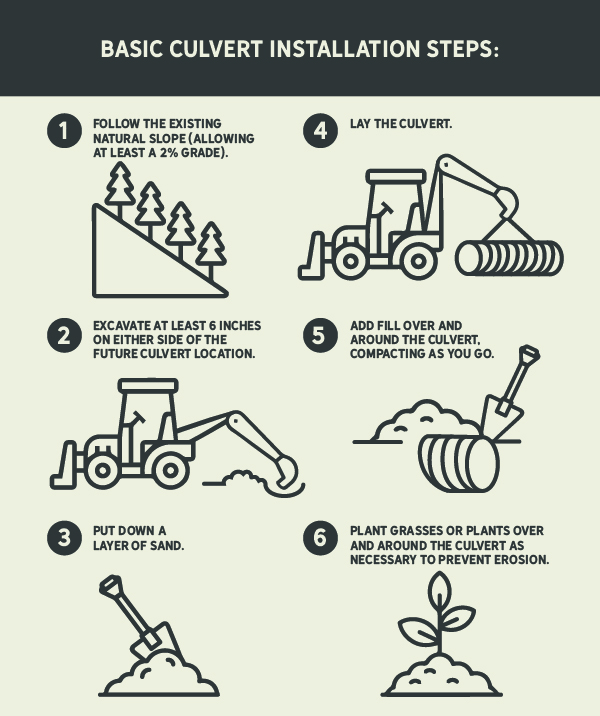

Protect Your Land with the Right Culvert
When you need to move water under a road, a driveway, or a segment of land, a culvert is ideal for the job. Similar to a large pipe, a culvert is a relatively simple, customizable way to move water from one place to another. Is a culvert right for your needs? And how do you pick the right one? McCoy’s makes it easy to break down these complex decisions.
What is a Culvert?
Culverts are fully enclosed drainage tunnel structures. They typically channel water, such as an existing stream or storm runoff, under areas including driveways, roads, or earth. Simpler than constructing a bridge over a running body of water, culverts divert the water while decreasing the chance of damage from flooding and erosion.
Different Types of Culverts
There are many designs for culverts, but the primary shapes are round, pipe-arch, structural plate, and box. Round culverts are most commonly seen in residential settings. In contrast, the others are more common in commercial or municipal settings.
- Pipe-arch culverts: Pipe-arch culverts are oval shaped and are frequently chosen in urban areas to manage storm sewer systems. They may be used singly or in multiples placed side-by-side. Because they lack corrugations along the bed of the waterway, fish or sewage easily drains through them.
- Structural plate culverts: Structural plate culverts are made from individual pieces of corrugated metal pipe and can provide an economical and durable option when a bridge is required at the site of a culvert. They can be constructed and installed quickly to exact dimensions.
- Box culverts: One of the most common culvert designs, box culverts are concrete or reinforced concrete structures that require a dry surface for installation. This fact makes them a poor choice for use on established waterways. However, their rigid design makes them simple to construct. They are frequently used as short-span bridges due to their squared-off shape.
Culvert Materials
When choosing culvert material, durability, and cost are frequently top of mind. Common culvert construction materials offer advantages and disadvantages, depending on where they are installed and how they are to be used.
- Corrugated metal: The corrugated shape is common in culverts due to its strength-boosting and water-slowing effects. But it can also capture silt and rocks, which can build up over time, causing erosion due to constant abrasion or blockage. If not large enough for debris, corrugated culverts may trap tree branches or other large items in floodwaters, blocking the water flow and potentially causing damage.
- Smooth metal: Smooth metal provides a fast exit for excess water, which can be helpful in a storm or an emergency. While smooth aluminum or galvanized steel metal can be strong, it can also be heavy and difficult to cut to fit a trench. However, if too weak, especially where road traffic runs over a culvert, it could buckle or warp.
- Plastic: Culverts made from plastic such as HDPE or PVC are lightweight, easy to move and install, and resist rust and corrosion. Plastic culverts can come in corrugated or smooth shapes. They may require special attention for installation because they need a considerable amount of fill above and around them to keep them from shifting. If they become clogged, smooth-walled plastic culverts are easier to clear out than corrugated ones.
- Concrete: Expensive to install, this type is more frequently seen in commercial settings, such as around large buildings or under public roads and highways.
How to Install and Use Culverts Correctly
If you need to plan for a greater water volume in the future, then use a larger-than-average diameter culvert. Consider the type of existing landscape around a culvert, as that can increase the amount of runoff. Factors from potential soil erosion to the size of the next big storm can lead to a small culvert being overwhelmed or a road surface giving way. Remember, these are only general guidelines.
Before you start digging, check building codes to determine if there are local regulations to follow on materials or culvert designs, including length and minimum diameter. In addition, you should contact your local power companies to have the proposed culvert area checked for utilities (typically a free service). You may also need to obtain permits before you start construction.
1. Determine Culvert Diameter
 When choosing a culvert, the amount of water to be carried will help determine the number and diameter of culverts you need. Typical culverts under driveways range from 12-15” in diameter, while others under roads typically are a minimum of 18” in diameter.
When choosing a culvert, the amount of water to be carried will help determine the number and diameter of culverts you need. Typical culverts under driveways range from 12-15” in diameter, while others under roads typically are a minimum of 18” in diameter.
To transport more water with smaller diameter culverts, you may also install two or more culverts side-by-side to handle heavy flows — but too narrow a culvert can become blocked with debris, even if there are many of them together. See the related graphic for a basic culvert diameter formula.

2. Determine Culvert Length
Total culvert length can be calculated, taking into account the slope and the distance necessary to move water. In general, the lengths are determined by the width of the roadbed or soil area you’re passing the culvert under. If culvert pipes are too short, erosion will occur on the edges. See this PDF resource for more details on determining the length for your culvert.

3. Basic Culvert Installation Steps:
While a small culvert can be installed using hand tools, renting excavating equipment is essential for large jobs and makes even small jobs easier.
- Follow the existing natural slope (allowing at least a 2% grade).
- Excavate at least 6 inches on either side of the future culvert location.
- Put down a layer of sand.
- Lay the culvert.
- Add fill over and around the culvert, compacting as you go.
- Plant grasses or plants over and around the culvert as necessary to prevent erosion.

Maintaining a Culvert
Pay special attention to preventing or clearing blockages before they become a problem. Monitor the water flow before a major weather event, like a hurricane, flood, annual storms, and snowmelt that cause an increase in volume. Clear out small debris and check for damage.
All types of culverts should be inspected regularly, especially after a major flood or weather event, to check for damage or erosion. Over time, metal culverts can become corroded due to high or low acidity in the water. Inspect culverts for rust, damage, or abrasions regularly, and plan to replace them before they break down completely.
McCoy’s Is Your Resource for Culverts
Before wet weather arrives, install your new culvert. You can shop the culvert selection at McCoy’s online, and have materials delivered or pick them up in our lumberyard. We carry accessories to help funnel the flow of water and connect different lengths of culvert. As always, we’re here to answer your questions and give you expert advice.



Reviewed by David Dollar
McCoy's In-House Expert
